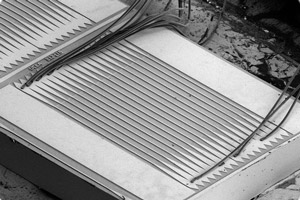- News
31 December 2015
UCLA develops first terahertz VECSEL laser
Funded by the US National Science Foundation (NSF), researchers at the Henry Samueli School of Engineering and Applied Science at University of California, Los Angeles (UCLA) have identified a new way to make a semiconductor laser that operates at terahertz frequencies (Luyao Xu et al, 'Metasurface external cavity laser', Appl. Phys. Lett. 107, 221105 (2015)).
Using the UCLA Nanoelectronics Research Facility for device fabrication, a team led by UCLA associate professor of electrical engineering Benjamin Williams (and including an engineer at Northrop Grumman Aerospace Systems) has created the first vertical-external-cavity surface-emitting laser (VECSEL) that operates in the terahertz range. VECSELs that use visible light have been used extensively to generate high-powered beams, but the technique has not previously been adapted for terahertz frequencies.
The terahertz range of frequencies (between microwave and infrared on the electromagnetic spectrum) can be used to analyze plastics, clothing, semiconductors and works of art without damaging the materials being examined; for chemical sensing and identification; and to investigate the formation of stars and composition of planetary atmospheres. The researchers say that their new development could lead to a new class of high-quality powerful lasers for use in space exploration, military and law enforcement efforts and other applications.
 Picture: Unlike a simple mirror, the metasurface amplifies terahertz waves as well as reflecting them.
Picture: Unlike a simple mirror, the metasurface amplifies terahertz waves as well as reflecting them.
To make it possible to build an external cavity laser with a high-quality beam, the researchers created a VECSEL with a 'reflectarray metasurface mirror', comprisng an array of many small antenna-coupled laser cavities such that, when a terahertz wave hits the array, it doesn't 'see' the cavities but rather is reflected as if it were being reflected from a simple, flat mirror. Unlike a simple mirror, however, the mirror amplifies terahertz waves as well as reflecting them.
"This is the first time a metasurface and a laser have been combined," says Williams. "The VECSEL approach provides a route to have higher output powers simultaneously with excellent beam quality in the terahertz range," he adds. "The metasurface approach further allows one to engineer the beam to have the desired polarization, shape and spectral properties."
Creating a beam that is symmetrical and straight over large distances and changing thermal conditions is a challenge for many semiconductor lasers but particularly for terahertz quantum cascade lasers, which normally use metal laser cavities with dimensions much smaller than the wavelength.
"By using this amplifying metasurface as part of the external cavity, not only can we improve the beam pattern but we can also introduce new functionality to this laser with different cavity designs," says Luyao Xu, a graduate researcher in Williams' lab and lead author of the study. "For example, by using a free-standing wire-grid polarizer, or filter, as a second mirror, we could optimize the lasers' output power and efficiency simply by rotating the polarizer."
The researchers say that they are already working on several new designs to further advance the technology.
http://scitation.aip.org/content/aip/journal/apl/107/22/10.1063/1.4936887


